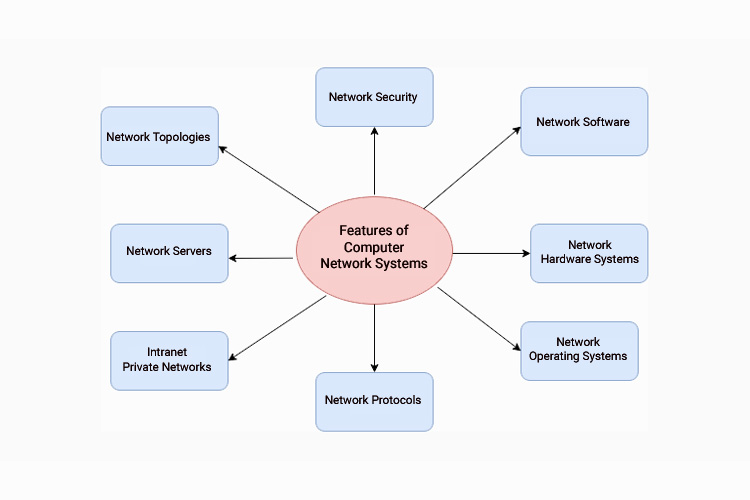Computer networks are essential for modern businesses. They allow employees to share files, access information and communicate with each other. Networks come in many shapes and sizes, but they all have a few common features. In this article, we will talk about the features of computer network systems in businesses.
Features of Computer Network Systems
Network Topologies
There are many network topologies, but they all share some common features.
Networks can be classified by their physical topology, or how the devices are physically arranged on the network. The most common physical topologies are bus, star, and mesh.
Their logical topology can also classify networks, or by how the data flows through the network. The most common logical topologies are ring and mesh.
Physical topologies are determined by the layout of the network cables and devices. With a bus topology, we connect all devices to a single cable, called a bus or backbone.
In a star topology, we connect each device to a central hub. In a mesh topology, we connect each device to every other device in the network.
Logical topologies are determined by the way data flows through the network.
Network Servers
A network server is a computer system, or more commonly, a set of related computer systems, that provides services to clients on the network. Think of a network server as a bunch of desktop computers connected to each other.
A client starts a request for service by connecting to the network server. The network server then processes the request and provides the requested service to the client.
Network servers can provide many types of services, such as file sharing, printing, and web serving.
Network servers are typically in a data center or other centralized location where they can serve multiple clients simultaneously.
Most networks include at least one network server to provide essential services. In smaller networks, this may be the only server on the network.
In larger networks, there may be several network servers providing different services.
Each workstation on a network connects to one or more network servers to access the services they provide.
Intranet: Private Networks
Intranet private networks are personal, internet-based networks that allow employees to connect and share files and resources with one another.
We can use intranets for a variety of purposes, such as communication, file sharing, and team collaboration.
Intranet private networks are created by using a special software application that turns a computer into a server.
Employees then use client software to connect to the server and access the network.
Intranet private networks can connect computers in different locations, or they can create a separate network within an existing company network.
Intranet private networks are secure to use, making them a popular choice for businesses of all sizes.
Network Protocols
Network protocols are a set of rules that govern how data is transmitted over a network.
They provide a framework for communication between devices on a network and allow devices to interoperate with each other.
Network protocols can transmit data over the internet, or within a local area network (LAN).
Most networks use the Transmission Control Protocol/Internet Protocol (TCP/IP) suite of protocols.
TCP/IP is a suite of protocols that were designed for the internet and is the most widely used networking protocol suite in the world.
It provides a framework for addressing devices on a network, and for transmitting data between devices.
Other network protocols include the Ethernet protocol, which is used to transmit data over LANs, and the Wireless Fidelity (Wi-Fi) protocol, which is used to transmit data over wireless networks.
Network Operating Systems
When most people think of computer operating systems, they usually think of the big three: Windows, Mac OSX, and Linux.
However, there are many other types of operating systems available, including network operating systems.
The design network operating systems for networks typically have features that make them well-suited for this type of environment.
For example, they may include features that allow them to be centrally managed or that provide better security than traditional operating systems.
Some common network operating systems include Microsoft Windows Server, macOS X Server, and various flavors of Linux, such as CentOS and Ubuntu Server.
Network Hardware Systems
Network hardware systems are the backbone of the internet. The mainframe is the central processing unit that coordinates all traffic and data communication between users and devices on a network.
The mainframe contains primary memory, secondary storage, and a series of input/output processors that manage communications with attached devices.
Network hardware systems also include routers, switches, and gateways that direct traffic to the destination and manage access to resources on the network.
For example, if a user requests a web page from the mainframe, the mainframe forwards the request to the gateway for processing.
The gateway then redirects the traffic to a specific application on the servers that are part of an application server cluster.
Network Software
Network software is a type of computer software that helps manage a computer network.
It handles tasks such as routing and forwarding packets, configuring and managing devices, and monitoring network health.
We can break network software down into two categories: programs that run on individual devices, and programs that run on a centralized server.
Individual device-based network software includes programs like the Network Interface Card (NIC) driver, which helps manage the physical connection between the device and the network.
Other examples include protocols like DHCP and ARP, which help devices communicate with each other on the network.
Server-based network software manages all the devices on the network from a central location.
This type of software can include features like routing tables, firewall rules, and device management tools.
Network Security
Network software is a type of computer software that helps manage a computer network.
It handles tasks such as routing and forwarding packets, configuring and managing devices, and monitoring network health.
We can break network software down into two categories: programs that run on individual devices, and programs that run on a centralized server.
Individual device-based network software includes programs like the Network Interface Card (NIC) driver, which helps manage the physical connection between the device and the network.
Other examples include protocols like DHCP and ARP, which help devices communicate with each other on the network.
Server-based network software manages all the devices on the network from a central location. This type of software can include features like routing tables, firewall rules, and device management tools.
Conclusion
In conclusion, computer network systems are an important part of our everyday lives. They allow us to communicate with others, access information, and purchase items.
For example, the Internet allows us to send emails, check stock prices, and research products and services. The networks that make all of this possible are called TCP/IP networks.
TCP/IP is a set of standards to manage communication between computers on a network. By understanding the features of these systems, we can make the most of their potential.




